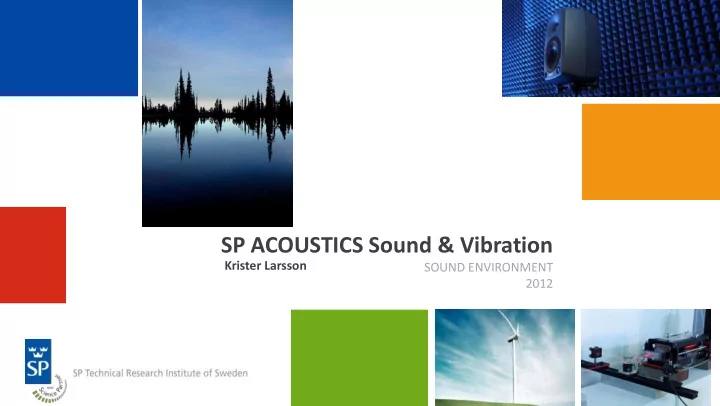

SP ACOUSTICS Sound & Vibration Krister Larsson SOUND ENVIRONMENT 2012
SP ACOUSTICS CORE AREAS • Measurement technology and calibration • Building and room acoustics • Machine and vehicle acoustics • Environmental noise
SP ACOUSTICS LABORATORY Sound transmission suit Large Reverberation chamber Hemi-anechoic Smaller reverberation chambers
SP LISTENING LABORATORY Auralisation Listening tests Product development
CALIBRATION AND MEASURMENT TECHNOLOGY National Metrology Centre, sound and vibration Calibration services • Sound level meters and microphones • Vibration meters and transducers • Dynamic force • Sound analysers and fft analysers • Sound and vibration calibrators • Reference sound sources • Tapping machines • Artificial ears and mastoids
BUILDING AND ROOM ACOUSTICS Sound insulation in buildings Impact and drum noise Building service equipment noise Structure borne sound Absorbers Smart textiles Standardisation
MACHINE AND VEHICLE ACOUSTICS Sound insulation in complex structures Damping materials Absorption Tyre – road noise Noise and vibrations in ships Vibrations
ENVIRONMENTAL NOISE Sustainable cities Transportation noise Wind energy Energy production
SP Shipping and offshore acoustics
Problem description • Noise and vibration sources
Problem description • Transmission paths – Air borne – Liquid borne (water) – Structure borne
Sound – Energy and information Acoustic efficiencies 2 10 -7 Normal electric motor: We have to deal with 1 10 -6 Jumbo jet aircraft: the management of 1 10 -6 Low pressure fan Energy! 5 10 -4 Human voice 5 10 -2 Loudspeaker Information: wanted and unwanted
Noise control engineering • Management of energy
Sound propagation in structures Longitudinal waves C Steel =5000 m/s, C rubber =400m/s Stiffness, density Rotational waves, transversal waves Flexural (bending) waves Stiffness, density, geometry
Dispersion of bending waves Speed bending waves Force acceleration frequency f c B < B >
Sound, structures and their interaction • Sound radiation from vibrating structures (bending waves) >f c <f c
Critical frequency • Influencing parameters – Mass per unit area – Bending stiffness Speed bending waves • Lightweight stiff structures are normally good sound radiators Increasing mass-stiffness ratio frequency
Finite structures, modes and resonances 112 Hz 12 Hz 243 Hz 387 Hz
Reduce sound at a receiver Isolation Damping • Block the transmission path • Dissipation of energy, convert sound energy to heat • Structure borne sound • Structure borne sound – Blocking mass – Damping layers (eg bitumen) – Blocking stiffness – Loss factor – Joints • Air borne sound – Vibration isolation (eg Sylomer or Sylodyn) – Absorption, Suspended ceilings, curtains, – Dynamic stiffness textiles • Air borne sound – Absorption coefficient – Sound insulation – Wall panels, enclosures – Reduction index
Isolation, insulation Reduction index R: Relation of transmitted power to incident power Incident wave field Block the transmission path Transmitted wave field Reflected wave field sudden impedance change Impedance: reaction force due to a given motion
Air-borne sound insulation of simple panels Reduction index R stiffness mass controlled first resonances bending stiffness, mass, damping
Measurement examples Air-borne sound insulation Single panels 6 dB/octave
Double wall design If you want to reduce weight you have to spend space 80 70 60 50 Reduction 40 [dB] 30 Heavy layer 20 Spacer 10 Steel 0 100 1000 frequency [Hz] Double wall resonance
Absorption Porous absorbers Viscous friction Absorption coefficient Panel absorber Resonance absorber Membrane absorber
Measurement of absorption in an diffuse field S, reverberation time T is a measure for the equivalent absorption area A=S
Measurement of absorption in the Kundt’s tube Advantage: small samples Disadvantage: samples have to be fitted very accurately into the tube
Damping layers Damping layer steel damping layer has to do work! right spot, sufficient stiff
THE END There is much more to know
Recommend
More recommend